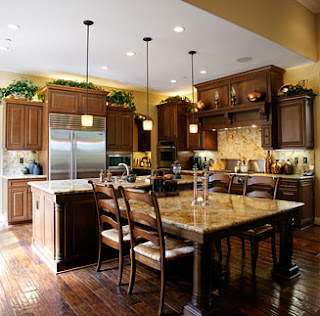
Lighting a kitchen is not like lighting other rooms in your house. Kitchens demand several types of lighting - such as task lighting and ambient lighting - that you'll want to incorporate equally into your kitchen design.
To achieve a feel-good kitchen, start by considering the ambient lighting or overall brightness. Factors include:
Kitchen size. Larger kitchens will require brighter bulbs or additional light fixtures; smaller kitchens won't require as bright or as many lights.
Light needed to see well into cabinets and drawers. Where light fixtures are placed relative to cabinet openings is important -- avoid lighting negatives such as a "scalloped" light effect.
Wall color and cabinet finish. Lower intensity lighting will be sufficient for walls that are all-white or light in color. Darker walls or dark finishes on cabinets will require higher intensity ambient lighting.
Location and number of windows and doorways. In addition to the number of windows in the kitchen, doorways to other rooms, skylights and patio doors may play a huge role in ambient lighting. Also consider the direction windows face and how that will affect the light at various times of year.
Light needed to see well into cabinets and drawers. Where light fixtures are placed relative to cabinet openings is important -- avoid lighting negatives such as a "scalloped" light effect.
Wall color and cabinet finish. Lower intensity lighting will be sufficient for walls that are all-white or light in color. Darker walls or dark finishes on cabinets will require higher intensity ambient lighting.
Location and number of windows and doorways. In addition to the number of windows in the kitchen, doorways to other rooms, skylights and patio doors may play a huge role in ambient lighting. Also consider the direction windows face and how that will affect the light at various times of year.
Deciding on the lighting for your kitchen means you must consider both the type of fixtures you want and their ideal placement. Lighting variety is limited only by your wants and desires - styles range from contemporary to traditional, in materials that include pewter, nickel, bronze, brass and glass.
With basic wiring skills you can complete both of these lighting upgrades in one day. As with any electrical work, your first step is to turn off the power to the circuits you plan to work on at the main panel. And before you handle any of the wires, use a circuit tester to make sure the circuits are shut down.
No comments:
Post a Comment